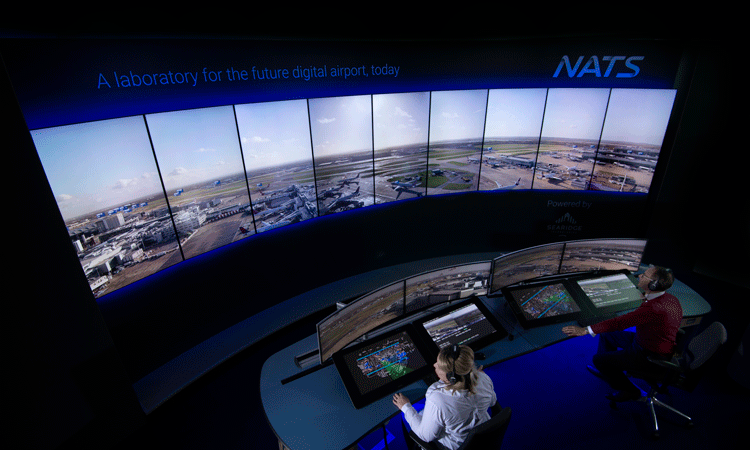Martin Rolfe, CEO of NATS, provides an overview of the challenges facing the aviation sector in the midst of one of the greatest periods of change in its history.


c: NATS
Aviation has been and continues to be an overwhelming source of good in the world, but it also faces major challenges that it must overcome in the years and decades ahead if we are to ensure a ‘better future’. I have focused on three transformation areas where the ATM community has a unique role to play in helping the industry continue to be successful, sustainable and safe.
Measures to address the climate crisis
This must be a decade of action on climate change. The industry is rightly driving new technologies, notably Sustainable Aviation Fuels (SAF), hydrogen/electric aircraft and fleet renewal. Great progress is being made with airlines ordering record numbers of new aircraft, but production will only be able to come on stream gradually and, as far as SAF is concerned, the reality is that we are still a long way from scalability.
It is therefore vital that ATM does all it can to support aviation by leveraging existing techniques, technologies and airspace modifications to reduce emissions, particularly in the short term. The use of known techniques and technologies to improve operational efficiency – such as Intelligent Approach – combined with the modernisation of airspace design worldwide could reduce aviation’s greenhouse gas emissions by 5-6%.
Part of the problem is knowing what and how to measure airspace and ATM efficiency. That’s why NATS is developing Green Aviation Insights, or GAIN, to try to create the world’s first truly global airspace efficiency index. We believe such a tool – based on 3Di, our three-dimensional airspace efficiency algorithm – could support the adoption of a universally consistent and meaningful set of metrics calculated daily from operational flight data, airspace configuration, and contextual information such as personnel, regulations, and weather.
This could help all air navigation service providers and their stakeholders to better understand the environmental impacts and opportunities of their operations. For those looking to monitor trends, identify hotspots and track the impact of their environmental initiatives, this could be critical.


c: NATS
The truly digital airport is coming
If an airport’s air traffic relies on visual, “analog” data, that data cannot be accessed, analyzed, shared, enhanced, or improved. In short, it cannot be used to improve the efficiency of operations. This is where we’re trying to create a paradigm shift with digital towers and the technology that underpins them. Once you digitize those views, you open up a whole new world of possibilities and the beginning of a truly digital airport.
The introduction of cameras into airport operations, whether fully digital or hybrid, brings some immediate benefits. Locations on the airfield that could be miles away from the control tower are now visible with absolute clarity. Views that were previously obscured are now clear and close, with the option to overlay important flight information as well. This improves an air traffic controller’s situational awareness and allows air traffic to adapt and grow as the airport itself does. It also eliminates the need for large airports to have multiple control towers with all the associated costs and complexity.
But it’s about much more than just giving air traffic controllers better visibility, as important as that is. Once you digitize these operational views, you can really make a difference – not just in the control tower, but across the entire airport. That’s exactly what’s happening today at Hong Kong International Airport.
Everything from stand plan optimization, queue monitoring, traffic light automation, CDM integration and even a fully digital Airport Performance Operation Cell is now possible on a single, integrated technology platform. This is only possible when you move that visual data from analog to digital and it is truly transformative when it comes to airport efficiency and performance.
Make room for new users
The third major area of transformation facing our industry relates to what we refer to as new airspace users. In 2021, NATS established the Beyond Visual Line of Sight (BVLOS) Operations Forum to bring the community together. The Forum published a white paper entitled ‘South of the Clouds’, which sets out the regulatory developments needed to take the industry to the next level.
While BVLOS flights are currently operated in segregated airspace to keep them safely separated from manned aircraft, this is neither sustainable nor scalable for a rapidly growing industry. The industry must find a way to accommodate BVLOS and other new operators without hindrance. This means new regulations, new technologies and new ways of working.


Digital tower laboratory.
c: NATS
NATS’s New Airspace Users Roadmap aims to provide some answers and is based on the principles of safety, equity, innovation and inclusion of all airspace users. While part of our vision is focused on infrastructure and data sharing, we also consider the processes needed to safely integrate manned and unmanned flights. Our focus is on providing the infrastructure and services that make it easier for new airspace users to start flying.
Last year was a significant moment in that journey. First, we had a shared vision for the delivery of aviation and data exchange services. NATS OpenAir would provide the fundamental building blocks on which to develop the services that new airspace users need to integrate safely with other aircraft – for example, knowing where other traffic is flying and avoiding schedule conflicts. It would not primarily provide services directly to operators, but would provide air navigation service providers with a central source of information that they can use to deliver safe and reliable relay services to their users. Given the importance of these services to new users, it is vital that we get them right. That is why we are spending much of this year consulting with industry partners, end users and the wider aviation community before submitting a formal proposal to the Civil Aviation Authority (CAA) next year.
We have also now seen real breakthroughs in two projects as part of the UK Future Flight Challenge.
In October 2023, Project Caelus conducted a BVLOS drone flight from Glasgow Airport to demonstrate that BVLOS operations were possible in the controlled airspace of a busy international airport. Our teams worked to ensure the procedures were in place to conduct a safe flight, while our analytics and R&D teams developed the technology and simulation models needed to prove how this one flight could be scaled. For regional airports in particular, this represents a huge opportunity to diversify their operations and one day become drone logistics hubs.
On Advanced Air Mobility (AAM), in December we conducted the first large-scale simulations of electric vertical take-off and landing (eVTOL) flights in UK-controlled airspace. This was a major milestone in proving the viability of AAM in the UK. We simulated a series of eVTOL flights from Bristol Airport, through the airspace around Farnborough and then to London City Airport. But what was groundbreaking was the combination of new prototype technology and the creation of a new ‘Airspace Manager’ capability. During the simulations, eVTOL operators submitted their flight plans via an app, which could then be approved or amended within minutes, with each flight cleared of other aircraft before take-off. The ‘Airspace Manager’ then monitored the airspace from a digital ‘Master Control Room’.
While not yet a finished product, our goal is to achieve the best balance between safety and airspace access for AAM without increasing the workload of air traffic controllers or pilots. It also opens the door for airports to become “vertiports” where eVTOLs operate seamlessly alongside existing traffic.
Transformation may be an overused word, but aviation is indeed in the midst of one of the biggest periods of change in its history. From tackling the climate crisis to embracing digitalisation to welcoming new users to our skies, air traffic management has a historic opportunity to play a leading role in shaping and securing the future.

 Martin Rolfe took up the post of Chief Executive in May 2015, having served as Managing Director, Operations since 2012, with responsibility for NATS’s commercially regulated UK and North Atlantic services.
Martin Rolfe took up the post of Chief Executive in May 2015, having served as Managing Director, Operations since 2012, with responsibility for NATS’s commercially regulated UK and North Atlantic services.
Martin is an engineer by training and holds a Masters degree in Aerospace Systems Engineering from the University of Southampton. He has 30 years’ experience in the defence and aerospace industries.
